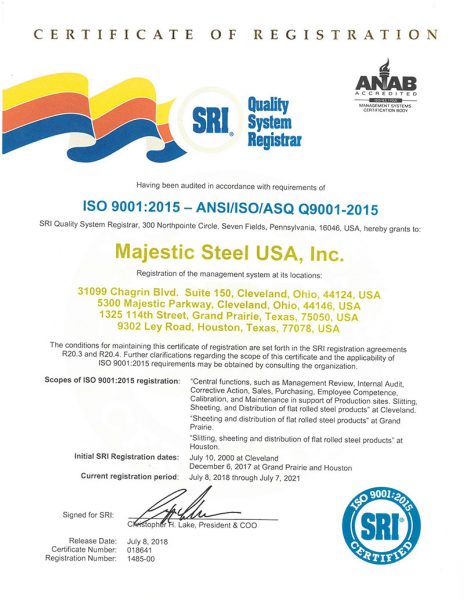Market Update | October 5, 2022
BRICK-AND-MORTARS EMERGING FROM THE PANDEMIC WITH STRENGTH
Brick-and-mortar store owners are emerging from the pandemic with surprising strength, posting some of their best numbers in years and plotting expansions as more Americans venture out to buy things again. U.S. retail vacancy fell to 6.1% in the second quarter, the lowest level in at least 15 years, and more stores opened than closed in the U.S. last year for the first time since 1995.
Input Costs
The recent up and down movement for zinc continued this week, as pricing dipped slightly from last week.
-
-
Zinc pricing came in at $1.38/lb this week, remaining below $1.50/lb for the third straight week.
-
Spot iron ore pricing declined slightly this week sliding after climbing slightly last week and remained below $100/mt for the third consecutive month.
-
-
Spot iron ore pricing is currently at $95.30/mt, down 0.8% from the end of last week and is down 2.8% on a m/m basis.
-
Pacific Basin met coal pricing rebounded slightly this week, climbing to $266.50/mt.
-
-
Current pricing is up 3.9% from the end of last week and down 2.6% from this time last month.
-
Supply
After sliding the previous two weeks, domestic raw steel production increased slightly last week.
-
- U.S. steelmakers produced 1.700 million tons at an 77.1% utilization rate.
- YTD production is now down 4.1% from the same time last year.
Based on preliminary import licenses, the daily average for September (25 days) is down 8.1% from the daily rate in August.
-
- Coated sheet imports are down 12% compared to the same time frame in August and are on pace to have their lowest monthly total in nearly two years.
- Excluding volatile slab imports, the daily average is down 10.5% from August.
DEMAND
Total construction spending continued to slide in August and is now down for the second consecutive month.
-
-
Total spending came in at a $1.781 trillion rate in August, down 0.7% from July but still up 8.5% from a $1.642 trillion rate in August 2022.
-
While climbing, on a year-over-year basis, for the 39th consecutive month, this was the lowest year-over-year percentage increase since March 2021.
- Both residential and non-residential total spending decline in August, sliding 1.0% and 0.4%, respectively.
- Residential spending has now declined in three consecutive months and is at its lowest level since February.
- The total spending breakout, between residential and non-residential, remained relatively flat compared to July; as residential spending made up 51.8% of the total.
-
Economic activity from the manufacturing sector continued to grow in September, just at its slowest rate in over two years.
-
-
The September ISM Manufacturing Index came in at 50.9, down from 52.8 in August and 61.1 in September 2022.
-
This is the lowest the index has been since May 2020.
- Any reading over 50.0 indicates growth, while any reading below 50.0 denotes contraction.
- The increases in production (+0.2) and inventory (+2.4), wasn’t enough to overcome the slowdowns seen in new orders (-4.2), order backlogs (-2.1), and employment (-5.5).
- Despite the slowdown in order backlogs, it remained above 50.0 for the twenty-seventh consecutive month.
-
U.S. light vehicle inventory continue to recover in September, now up for the second consecutive month.
-
-
U.S. light vehicle inventory ended September at 1.428 million units, up 12.6% from August and up a sharp 46.8% from 972,665 units in September 2021.
-
Light vehicle inventory is now up, on a year-over-year basis, for the third consecutive month.
- Inventories of both cars and light trucks increased in September, climbing 13.6% and 14.6%, respectively.
- Light truck inventory topped 1.0 million units for the first time since April 2021.
- The current inventory, when combined with September’s sales rate, equates to 32 days of supply.
- This is up from 29 in August but still well below the historically normal level of 65 days.
-
Bricks-and-mortar store owners are emerging from the pandemic with surprising strength, posting some of their best numbers in years and plotting expansions as more Americans venture out to buy things again.
-
- U.S. retail vacancy fell to 6.1% in the second quarter, the lowest level in at least 15 years, and more stores opened than closed in the U.S. last year for the first time since 1995.
This material, information and analyses (the “Content”) may include certain statements, estimates and projections prepared with respect to, among other things, historical data and anticipated performance. Content may reflect various assumptions by Majestic Steel USA, Inc. concerning anticipated results that are inherently subject to significant economic, competitive and other uncertainties and contingencies and have been included for illustrative purposes. Content is provided AS-IS.

